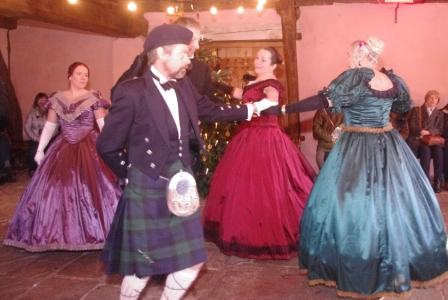Christmas is a time for fun and celebrations of every kind, and at the Ryedale Folk Museum, they’re celebrating dance.

Victorian Christmas
The Museum specialises in bringing a Victorian Christmas to life, with sausage rolls and mince pies cooked in a genuine black-leaded range, a historic sweet shop full of goodies, and the chance to learn some Victorian dancing. In the Manor House, historic dance troupe Arbeau demonstrate the dances of the time.
People dressed their best for a Victorian dance, and the troupe are magnificently turned out, the ladies in sweeping hoop-petticoat skirts, the gentleman in tailcoats.

Victorian dances
But Victorian dances were not, as in the disco today, a matter of personal expression. Steps and routines had to be learned, and performed precisely, lest you step upon your partner’s toes. There were printed instructions, and, for those who could afford them, dancing masters.
Upper class balls were glittering occasions, with silk dresses and hundreds of candles in crystal chandeliers. Other people danced at home, and if there wasn’t enough space indoors, danced outside. Jan Liddle-Hulme of Arbeau, says, “You can see peasants dancing outside in a Breughel painting.”
Dancing ‘like speed dating’
Dancing is exhilarating in itself, all that exercise and music bringing a glow. But its other great attraction is in meeting people – especially the opposite sex. In the Regency era, says dancer Alison Canham, people worked their way up and down dance sets, changing partners and talking to different people. “It was like speed dating,” comments husband and fellow Arbeau dancer, Richard Canham.
Alison adds, “You needed to be fit, too. A long room like York Assembly Rooms would take a long time to work up and down the set.”
Many historic dances are formal, with partners touching hands only, and steps meticulously made. Even in boisterous country dances, partners rarely touched more than a hand, or perhaps an arm. But then came the waltz.
Waltzing a scandal

The waltz was a scandal. The couple were in close hold, says Richard, “The man’s hand on the woman’s back, the woman’s hand on the man’s arm – bodies may touch!”
No wonder the waltz remained popular for generations.
Read more in Dalesman Magazine, Dec 2018 issue
